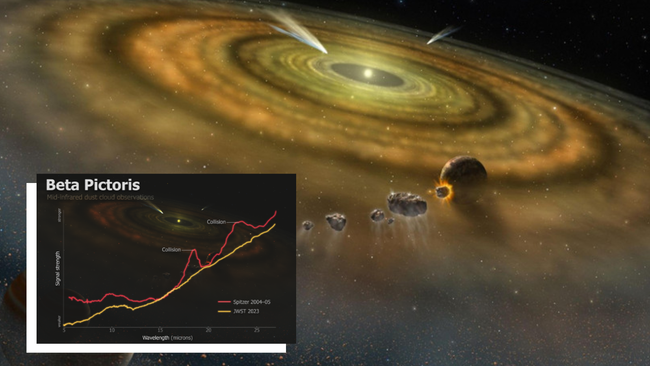James Webb Space Telescope Detects Asteroid Collision in Nearby Star System
‘What you may be witnessing here is how the rocky planets, and other bodies of this kind, are formed in front of your eyes.’
Asteroids colliding with each other in another star system could have been evidenced by the JWST. Some of the dust that was produced by the collision is estimated to be 100000 times the mass of the asteroid that killed the dinosaurs.

Asteroids were observed to collide in Beta Pictoris, a star system that lies approximately 63 ly away from Earth. 4 light years form the solar system. This star system is a relatively young one; it is approximately only 20 to 25 million years old which makes it young as compared to the 4. 6 billion-year-old solar system. Due to the early stages of planetary formation of Beta Pictoris, the JWST observation of asteroid impacts in the system might provide insights into the unstable processes that formed similar neighborhoods, including the solar systems in their early days.
Since Beta Pictoris is still a young star with planetary formation still ongoing in the terrestrial planet zone through the mode of giant asteroid collisions, what we are observing here is real-time formation of rocky planets and other bodies, said Christine Chen, the team leader and an astronomer at the Johns Hopkins University.
How the JWST saw changes around Beta Pictoris
However, the distance between the solar system and Beta Pictoris is large enough, and, as a result, it would be very challenging to directly observe asteroids colliding in it. Further than that, actually, you have to intercept a collision inside the disc, or a ‘protoplanetary disc’ of gas and dust surrounding a young star, in this case Beta Pictoris.
For this detection, the researchers led by Chen contrast new data obtained from JWST with observations from the Spitzer Space Telescope in 2004 and 2005. This showed that there are enormous shifts in energy variations of dust grains around Beta Pictoris in relation to heat from minerals normally associated with youthful stars and aboard our Earth’s orbit. Because they are termed as “crystalline silicates”.
Due to the increased spatial resolving power of JWST the team was able to search for dust particles in the area of Beta Pictoris that was previously surveyed by Spitzer. It is worth noting that they did not detect particles that Spitzer saw twenty years ago. This meant that an asteroid or some other cosmic body flying around Beta Pictoris had a major accident about 20 years before. Any such smash-up would have reduced these bodies to powder, to a shower of particles finer than the white sugar grains.
‘We believe all that dust is what we saw at the beginning in data by the Spitzer telescope in 2004 and 2005,’ said Chen. As for the JWST new data, the best scenario described from them is that we actually saw the aftermath of a rare and titanic event between two large bodies on the scale of an asteroid, which is a complete turnover in the comprehension of this star system.
Asteroid-collision dust is absent in the JWST images because radiation from the star Beta Pictoris has since dispersed any such particles. The emissions seen by Spitzer 20 years ago represented the beginning of this process, when the dust was being heated by stellar radiation and emitting thermal energy. Moving away from the central star has also caused the dust to cool, meaning its thermal emission is no longer occurring.

Earlier observations conducted by Spitzer had suggested that the region contained small bodies that ground down and constantly replaced the dust over time, which surrounded Beta Pictoris. However, data collected by JWST shows that the outer dust, which gets pushed away by the central star, is not replenished.
Due to Beta Pictoris close distance and the fact that it hosts two young exoplanets this has made this system one of the most popular targets for astronomers trying to understand the mechanics of planetary formation.
“The question we are trying to contextualize is whether this whole process of terrestrial and giant planet formation is common or rare, and the even more basic question: ”Are planetary systems like the solar system that rare?” team member Kadin Worthen, a doctoral student in astrophysics at Johns Hopkins, said in the statement. “We’re pretty much simply trying to find out how odd or normal we are. ”
This new research showcases the JWST’s potential in understanding the complexity of planetary systems and extrasolar planets also known as ‘exoplanets. ’ The 10 billion dollars space telescope is likely to unlock the mystery of why some planetary systems form like the solar system and why others have different formations.
The JWST could also aid astronomers to find out how early-time turbulence surrounding stars affects the atmospheres, water content, and other aspects of habitability for their planets.
“Almost all the discoveries made by JWST stem from what the telescope observes directly,” said team member Cicero Lu, a former doctoral student in astrophysics at Johns Hopkins University. ‘In this case, the story is a little different because our results come from what JWST did not see. ’
The team presented their resents on Monday (June 10) at the 244th Meeting of the American Astronomical Society in Madison, Wisconsin.
Do not forget to share your opinion with us to provide you with the best posts !



0 Comments